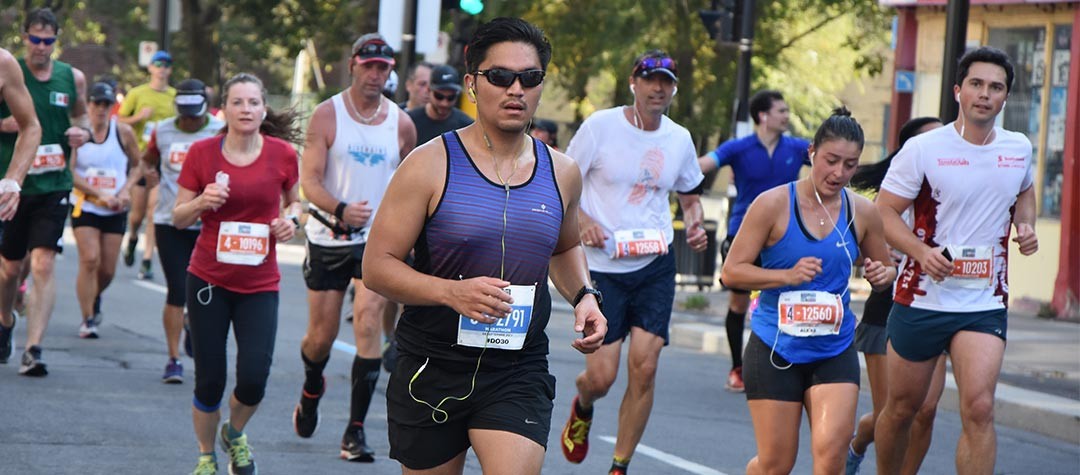When it comes to the half marathon distance, getting your tactics right is the key to a good time.
You probably don't need reminding that 13.1 miles or 21 km is a long way, so it makes sense to have a clear race strategy which can really help you feel more confident and finish faster. Tactical errors are probably one of the biggest causes of post-race frustration for runners, so make sure you're one of those runners who don't have half marathon regrets.
1. Learn the course
Before you've even set foot on the start line, you need to learn the half marathon course like the back of your hand. Very few races over the half marathon distance are completely flat, so take a look at the course beforehand and identify any hilly areas where you might struggle. This will allow you to adjust your split times accordingly. You should also study any narrow sections of the course that are likely to be congested, or exposed areas that could be vulnerable to heavy winds. Every second counts in a half marathon, so doing some simple course research is guaranteed to pay off.
2. The start
It’s all too easy to get carried away at the start on race day; your legs feel fresh from tapering and with some extra adrenaline flowing through your veins, you may well feel pretty invincible, well for the first few miles/kilometres at least! An over-zealous start nearly always results in a slow and painful finish. Added to the pain and misery of a slow finish is the realisation that you can also kiss goodbye to an opportunity of running a personal best or personal record.
An over-zealous start nearly always results in a slow and painful finish.
To avoid temptation, start the race with runners of your ability, not those who are faster than you. If it's a mass start then it’s really worth trying to avoid weaving in and out of other runners, because this just wastes precious energy. Try to settle into a good rhythm and relax. It is supposed to be fun!
3. Paced to perfection
For the longer distances, (half marathon and above), conserving glycogen in the first half of the race is crucial. The smartest runners are those who spread their effort over the duration of the race by running even or negative splits (where the second half of the race is run faster than the first). Try not to think that getting ahead of your desired splits early on is 'money in the bank'. It isn’t. In fact it generally results in early glycogen depletion ('hitting the wall') and slower finishing times.
4. You should still be smiling at 10 km!
If you've paced your race well then you should still feel in control and still be smiling at the 10 km mark (6.2 miles). Now is the time to start to gradually increase your pace. But remember that this needs to be done in a controlled manner over the course of a mile. Please don't be tempted to inject a sudden burst of speed, it generally doesn’t work.
5. Take the racing line
Certified road race courses are measured using the shortest route available. This means that running down the middle of the road isn't necessarily the fastest route. Focus on taking the race line, particularly if the road bends a lot. Running the tangents of a course is essentially free speed and could take several seconds off of your finish time.
6. Take shelter
In cycling the tactic of drafting is commonly used as a means to conserve energy; the same tactic can be applied to half marathon running. The faster you run, the more energy is required to overcome air resistance and running into a headwind can also significantly increase energy costs. Try to 'tuck in' and shelter behind other runners, particularly if it's windy. Running in a group will also help you to maintain both pace and motivation.
In cycling the tactic of drafting is commonly used as a means to conserve energy; the same tactic can be applied to half marathon running.
7. Time your finish
Be sure to time your final surge to the line carefully. You may feel mentally that you are able to make one last effort, but after running 13 miles (21 km) your body might just have other ideas. A sudden increase in speed on fatigued legs could result in an untimely bout of cramp, which is the last thing you need at that stage. If you feel you are able to, the best way to generate some extra speed at the end of the race is to gradually increase your tempo over the last 200m. Many races have countdown distance markers which will help you time your finish, but some don’t, in which case you may want to make a mental note of the final stretch so that you don't start your final surge too early.
Picture credit: Greatest Shots / Shutterstock.com















